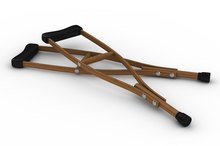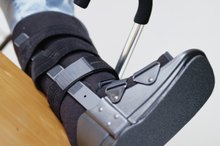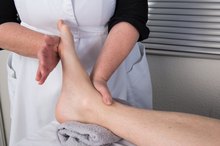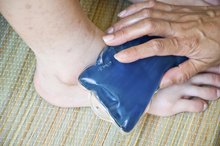Recovery for Foot Surgery to Remove Calcium Deposits
Feet can suffer from a variety of ailments. The forming of calcium deposits on various parts of the feet as people age is a condition seen frequently by podiatrists. Often, these calcium deposits will progress to a point where foot surgery is necessary. Recovery is generally of short duration and not difficult, though it does interfere with normal activities for a time.
About Bone Spurs
Bone spurs are calcium deposits that form due to chronic inflammation on parts of the foot that experience continuous rubbing or pressure. Bone spurs can occur on the heel or any of the toes, but usually involve the fifth toe, at the side or at the base. Calcium deposits can also grow along the top arch of the foot.
What Causes Calcium Deposits on Feet
Why You Have Heel Pain After Playing Basketball
Learn More
These calcium deposits form as a response from the body’s defense mechanism. When an area of bone is subject to constant pressure, rubbing or other stress, it responds by trying to repair itself, building more bone over a period of time. This can be caused by simple aging or overuse. As cartilage that slips over the bone wears down over this area of overgrowth, it can produce inflammation, swelling and pain.
Surgery for Calcium Deposits
Podiatrists generally perform bone spur surgery on an outpatient basis. The surgeon removes the bone spur on the toes by making a small incision on the affected area and filing down the bony outgrowth with a file or power bit. Then, the surgeon puts in a small stitch or two to close the wound. For heel spurs, the surgeon may partially cut the plantar fascia, the muscle that runs from heel to toe on the bottom of the foot, in order to access the heel bone to reach the deposit that is causing the trouble. The podiatrist then bandages the area and puts a special shoe or boot on the foot to protect it from injury while it heals. Podiatrists then instruct patients on changing the bandage at home. Stitches must remain in place for at least 7 to 10 days.
The Recovery Process
How to Heal From Peroneal Tendon Surgery
Learn More
Most patients are encouraged to be on their feet soon after foot surgery, though activities may be severely limited. Your surgeon will prescribe appropriate pain medication. Staying off the foot and elevating it helps reduce swelling. Your surgeon may advise you to avoid heavy exercise or prolonged standing for six to eight weeks. Surgeons have their own individual instructions for the recovery period.
Returning to Normal Activities
Most people can return to work within in a week, if heavy physical activity or special work shoes are not required. Driving ability may be limited during the healing process, and you may have to consult with your employers about more sedentary duties until you are completely healed. Your surgeon will be able to advise you about returning to full normal activity.









